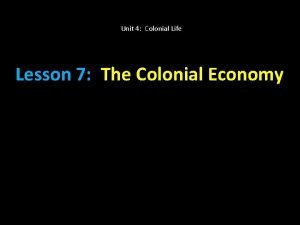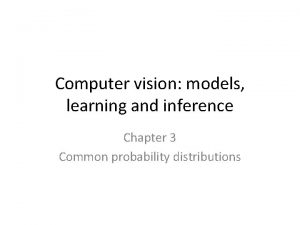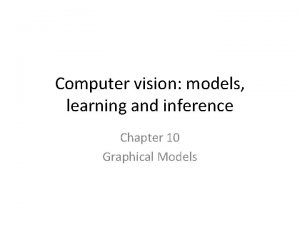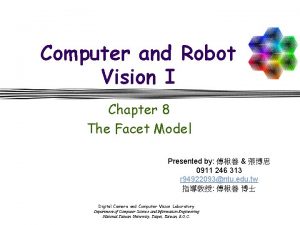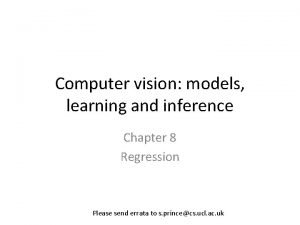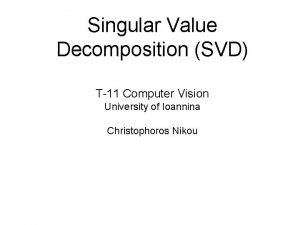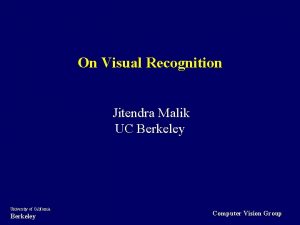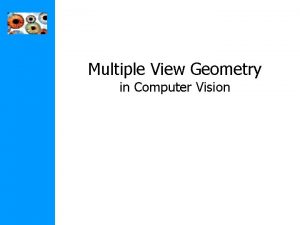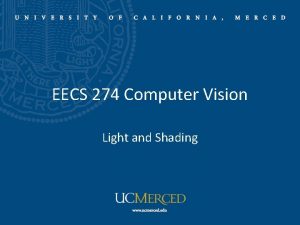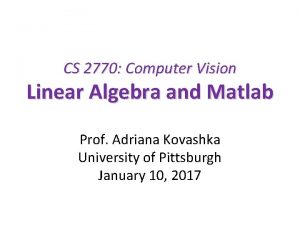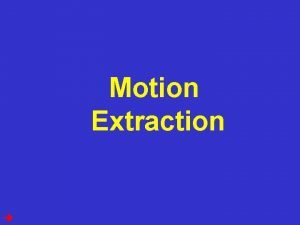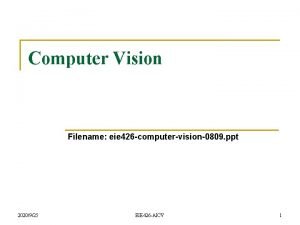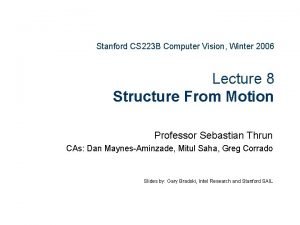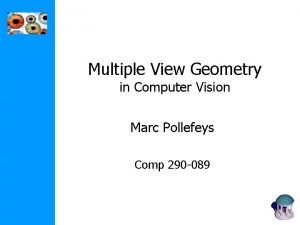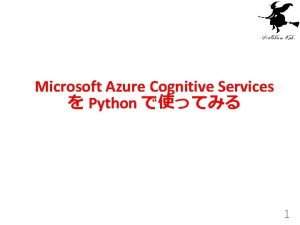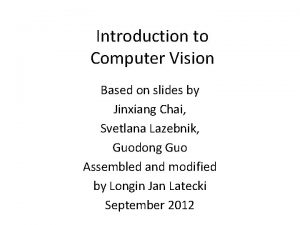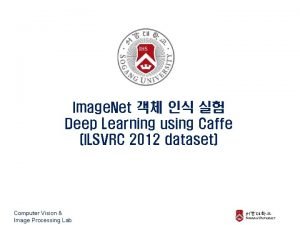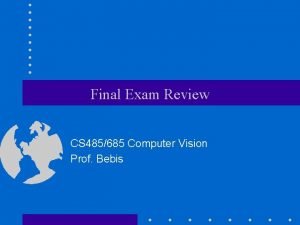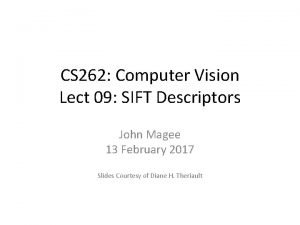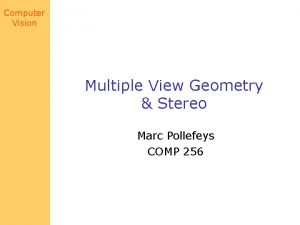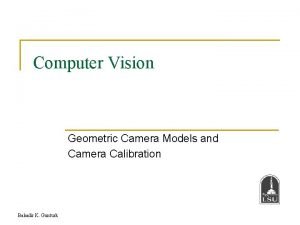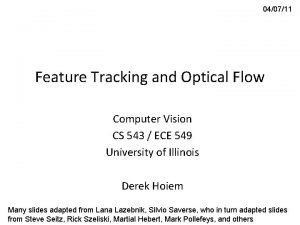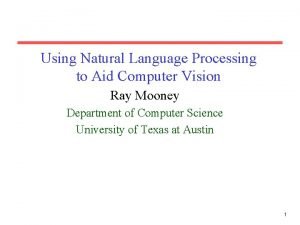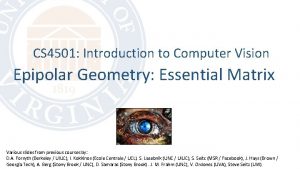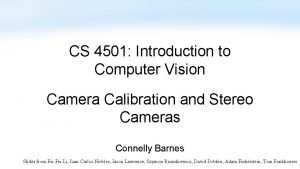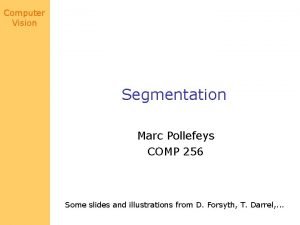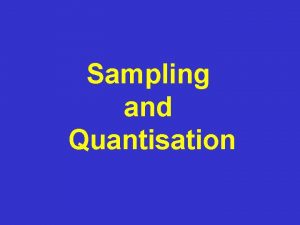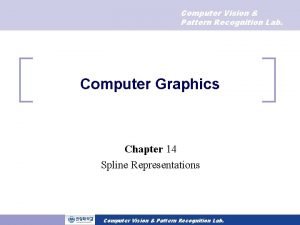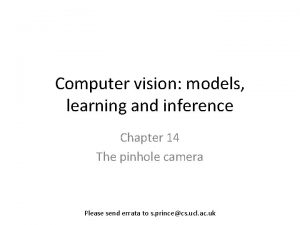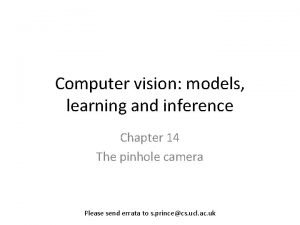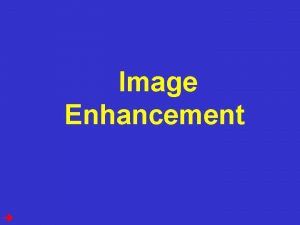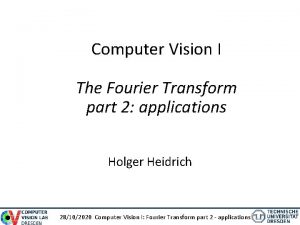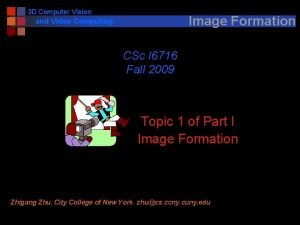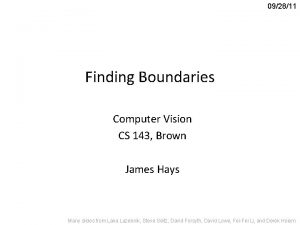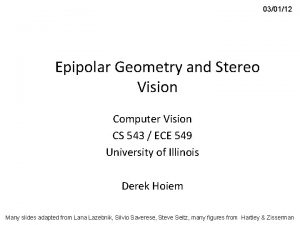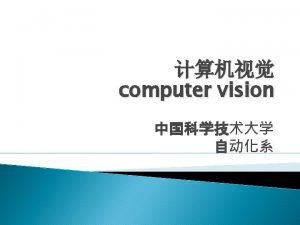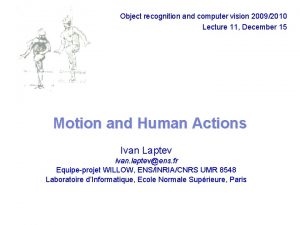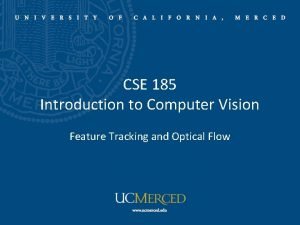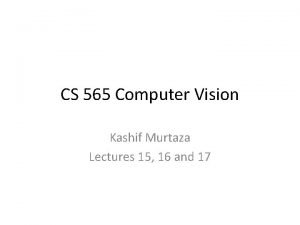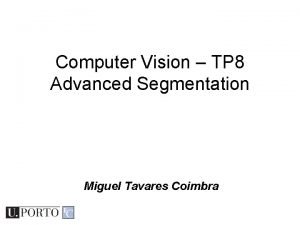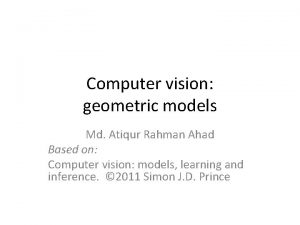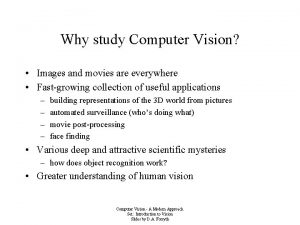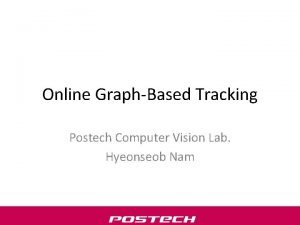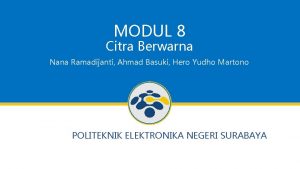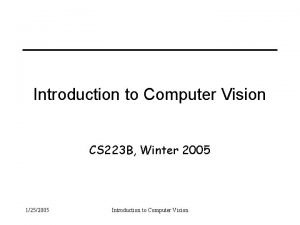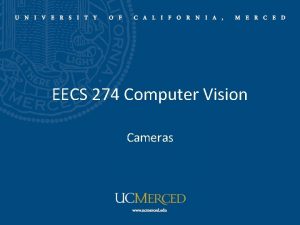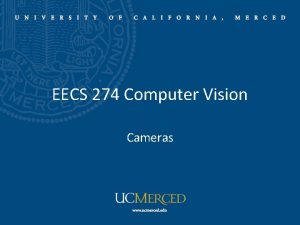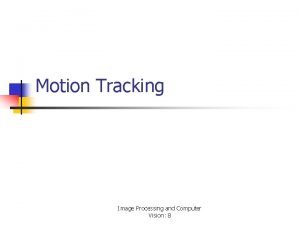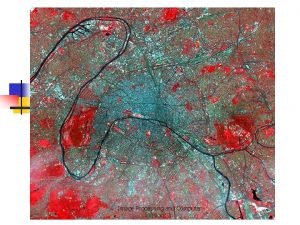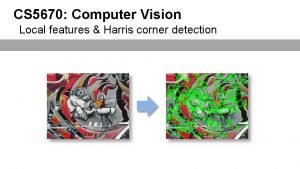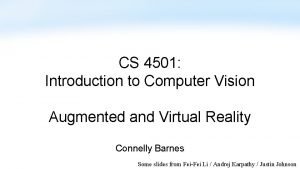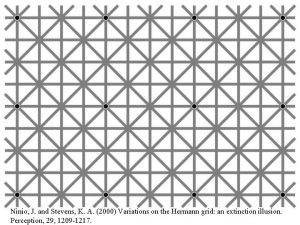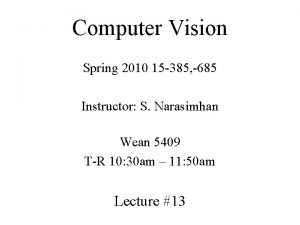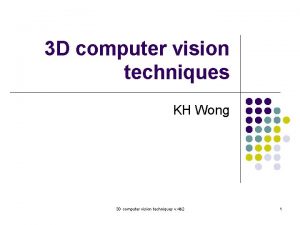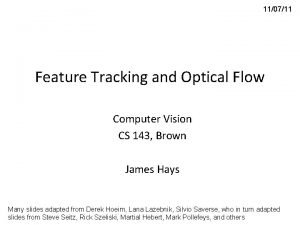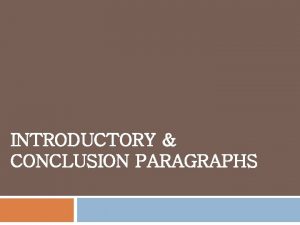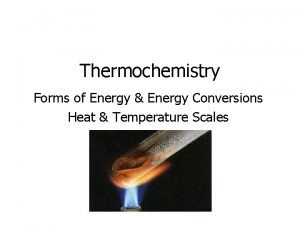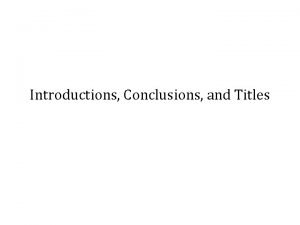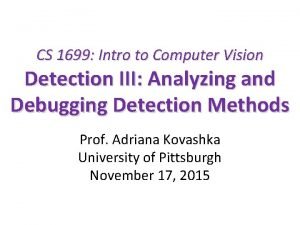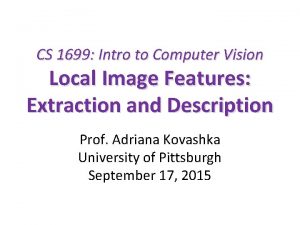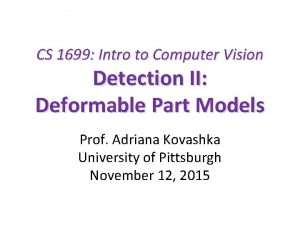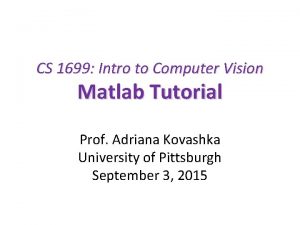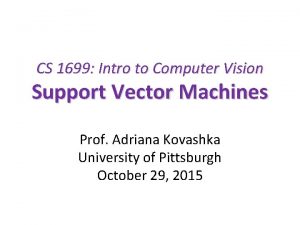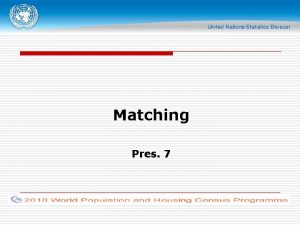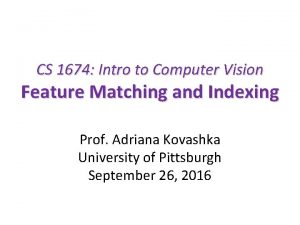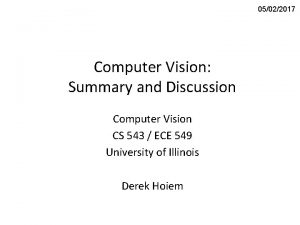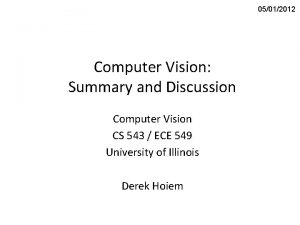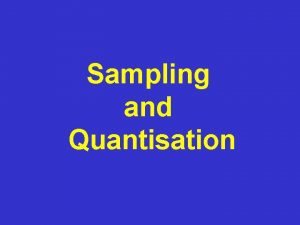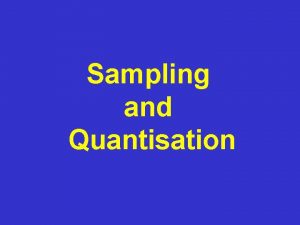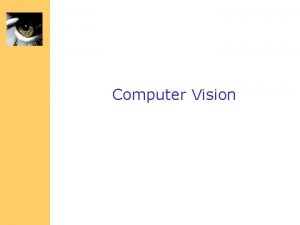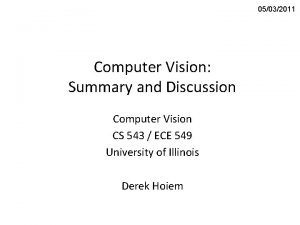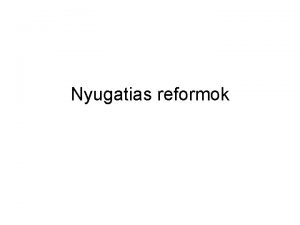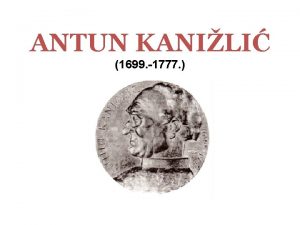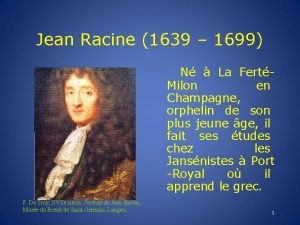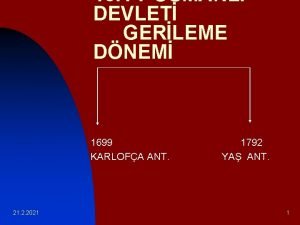CS 1699 Intro to Computer Vision Matching and









































































- Slides: 73

CS 1699: Intro to Computer Vision Matching and Fitting Prof. Adriana Kovashka University of Pittsburgh September 29, 2015

Today • Fitting models (lines) to points, i. e. find the parameters of a model that best fits the data – Least squares – Hough transform – RANSAC • Matching = finding correspondences between points, i. e. find the parameters of the transformation that best aligns points • Homework 2 is due 10/08

Fitting • Want to associate a model with observed features [Fig from Marszalek & Schmid, 2007] For example, the model could be a line, a circle, or an arbitrary shape. Kristen Grauman

Example: Line fitting • Why fit lines? Many objects characterized by presence of straight lines • Why aren’t we done just by running edge detection? Kristen Grauman

Difficulty of line fitting • Extra edge points (clutter), multiple models: – which points go with which line, if any? • Only some parts of each line detected, and some parts are missing: – how to find a line that bridges missing evidence? • Noise in measured edge points, orientations: – how to detect true underlying parameters? Kristen Grauman

Least squares line fitting • Data: (x 1, y 1), …, (xn, yn) • Line equation: yi = m xi + b • Find (m, b) to minimize Matlab: p = A y; Modified from Svetlana Lazebnik y=mx+b (xi, yi)

Hypothesize and test 1. Propose parameters – – – Try all possible Each point votes for all consistent parameters Repeatedly sample enough points to solve for parameters 2. Score the given parameters – Number of consistent points, possibly weighted by distance 3. Choose from among the set of parameters – Global or local maximum of scores 4. Possibly refine parameters using inliers Derek Hoiem

Voting • It’s not feasible to check all combinations of features by fitting a model to each possible subset. • Voting is a general technique where we let the features vote for all models that are compatible with it. – Cycle through features, cast votes for model parameters. – Look for model parameters that receive a lot of votes. • Noise & clutter features? – They will cast votes too, but typically their votes should be inconsistent with the majority of “good” features. Kristen Grauman

Fitting lines: Hough transform • Given points that belong to a line, what is the line? • How many lines are there? • Which points belong to which lines? • Hough Transform is a voting technique that can be used to answer all of these questions. Main idea: 1. Record vote for each possible line on which each edge point lies. 2. Look for lines that get many votes. Kristen Grauman

Finding lines in an image: Hough space y b b 0 x image space m 0 m Hough (parameter) space Connection between image (x, y) and Hough (m, b) spaces • A line in the image corresponds to a point in Hough space Steve Seitz

Finding lines in an image: Hough space y b y 0 x image space m Hough (parameter) space Connection between image (x, y) and Hough (m, b) spaces • A line in the image corresponds to a point in Hough space • What does a point (x 0, y 0) in the image space map to? – Answer: the solutions of b = -x 0 m + y 0 – This is a line in Hough space • To go from image space to Hough space: Steve Seitz – given a set of points (x, y), find all (m, b) such that y = mx + b

Finding lines in an image: Hough space y y 0 b (x 1, y 1) (x 0, y 0) b = –x 1 m + y 1 x 0 x image space m Hough (parameter) space What are the line parameters for the line that contains both (x 0, y 0) and (x 1, y 1)? • It is the intersection of the lines b = –x 0 m + y 0 and b = –x 1 m + y 1 Steve Seitz

Finding lines in an image: Hough algorithm y b x image space m Hough (parameter) space How can we use this to find the most likely parameters (m, b) for the most prominent line in the image space? • Let each edge point in image space vote for a set of possible parameters in Hough space • Accumulate votes in discrete set of bins; parameters with the most votes indicate line in image space. Steve Seitz

Hough transform y m b x y m 3 x Silvio Savarese 5 3 3 2 2 3 7 11 10 4 3 2 1 1 0 5 3 2 3 4 1 b

Parameter space representation • Problems with the (m, b) space: • Unbounded parameter domains • Vertical lines require infinite m Svetlana Lazebnik

Parameter space representation • Problems with the (m, b) space: • Unbounded parameter domains • Vertical lines require infinite m • Alternative: polar representation Each point (x, y) will add a sinusoid in the ( , ) parameter space Svetlana Lazebnik

Hough transform P. V. C. Hough, Machine Analysis of Bubble Chamber Pictures, Proc. Int. Conf. High Energy Accelerators and Instrumentation, 1959 Use a polar representation for the parameter space y x Silvio Savarese Hough space

Algorithm outline • Initialize accumulator H to all zeros • For each feature point (x, y) ρ in the image For θ = 0 to 180 ρ = x cos θ + y sin θ θ H(θ, ρ) = H(θ, ρ) + 1 end • Find the value(s) of (θ*, ρ*) where H(θ, ρ) is a local maximum • The detected line in the image is given by ρ* = x cos θ* + y sin θ* Svetlana Lazebnik

Hough transform example Derek Hoiem http: //ostatic. com/files/images/ss_hough. jpg

Impact of noise on Hough d y x Image space edge coordinates Silvio Savarese Votes

Impact of noise on Hough d y x Image space edge coordinates Votes What difficulty does this present for an implementation? Kristen Grauman

Impact of noise on Hough Noisy data features Need to adjust grid size or smooth Silvio Savarese votes

Impact of noise on Hough Image space edge coordinates Votes Here, everything appears to be “noise”, or random edge points, but we still see peaks in the vote space. Kristen Grauman

Algorithm outline • Initialize accumulator H to all zeros • For each feature point (x, y) ρ in the image For θ = 0 to 180 ρ = x cos θ + y sin θ θ H(θ, ρ) = H(θ, ρ) + 1 end • Find the value(s) of (θ, ρ) where H(θ, ρ) is a local maximum • The detected line in the image is given by ρ = x cos θ + y sin θ Svetlana Lazebnik

Incorporating image gradients • Recall: when we detect an edge point, we also know its gradient direction • But this means that the line is uniquely determined! • Modified Hough transform: For each edge point (x, y) θ = gradient orientation at (x, y) ρ = x cos θ + y sin θ H(θ, ρ) = H(θ, ρ) + 1 end Svetlana Lazebnik

Hough transform for circles • Circle: center (a, b) and radius r • For a fixed radius r, unknown gradient direction Image space Kristen Grauman Hough space

Hough transform for circles • Circle: center (a, b) and radius r • For a fixed radius r, unknown gradient direction Intersection: most votes for center occur here. Image space Kristen Grauman Hough space

Hough transform for circles • Circle: center (a, b) and radius r • For an unknown radius r, unknown gradient direction r ? b a Image space Kristen Grauman Hough space

Hough transform for circles • Circle: center (a, b) and radius r • For an unknown radius r, unknown gradient direction r b a Image space Kristen Grauman Hough space

Hough transform for circles •

Hough transform for circles • Circle: center (a, b) and radius r • For an unknown radius r, known gradient direction x θ Image space Kristen Grauman Hough space

Hough transform for circles • A circle with radius r and center (a, b) can be described as: x = a + r cos(θ) y = b + r sin(θ) (x, y) (a, b)

Hough transform for circles x = a + r cos(θ) y = b + r sin(θ) For every edge pixel (x, y) : For each possible radius value r: For each possible gradient direction θ: // or use estimated gradient at (x, y) a = x – r cos(θ) // column b = y – r sin(θ) // row H[a, b, r] += 1 end θ end x Modified from Kristen Grauman

Example: detecting circles with Hough Original Edges Votes: Penny Note: a different Hough transform (with separate accumulators) wa used for each circle radius (quarters vs. penny). Kristen Grauman, images from Vivek Kwatra

Example: detecting circles with Hough Original Combined detections Edges Votes: Quarter Note: a different Hough transform (with separate accumulators) wa used for each circle radius (quarters vs. penny). Kristen Grauman, images from Vivek Kwatra

Example: iris detection Gradient+threshold • Hough space (fixed radius) Hemerson Pistori and Eduardo Rocha Costa http: //rsbweb. nih. gov/ij/plugins/hough-circles. html Kristen Grauman Max detections

Voting: practical tips • Minimize irrelevant tokens first • Choose a good grid / discretization Too fine ? Too coarse – Too coarse: large votes obtained when too many different lines correspond to a single bucket – Too fine: miss lines because points that are not exactly collinear cast votes for different buckets • Vote for neighbors, also (smoothing in accumulator array) • Use direction of edge to reduce parameters by 1 • To read back which points voted for “winning” peaks, keep tags on the votes Kristen Grauman

Generalized Hough transform • We want to find a template defined by its reference point (center) and several distinct types of landmark points in stable spatial configuration Template c Svetlana Lazebnik

Generalized Hough transform • What if we want to detect arbitrary shapes? Intuition: Displacement vectors x xx Ref. point Model image x Novel image x Vote space Now suppose those colors encode gradient directions… Kristen Grauman

Generalized Hough transform Define a model shape by its boundary points and a reference point. Offline procedure: x θ a θ p 2 p 1 Model shape … θ θ … At each boundary point, compute displacement vector: r = a – pi. Store these vectors in a table indexed by gradient orientation θ. … Kristen Grauman [Dana H. Ballard, Generalizing the Hough Transform to Detect Arbitrary Shapes, 1980]

Generalized Hough transform Detection procedure: x For each edge point: • Use its gradient orientation θ to index into stored table • Use retrieved r vectors to vote for reference point … θ θ … Kristen Grauman … xx θ θ p 1 θ θ Novel image Assuming translation is the only transformation here, i. e. , orientation and scale are fixed.

Generalized Hough transform • Template representation: for each type of landmark point, store all possible displacement vectors towards the center Template Svetlana Lazebnik Model

Generalized Hough transform • Detecting the template: • For each feature in a new image, look up that feature type in the model and vote for the possible center locations associated with that type in the model Test image Svetlana Lazebnik Model

Generalized Hough for object detection • Index displacements by “visual codeword” with displacement vectors training image B. Leibe, A. Leonardis, and B. Schiele, Combined Object Categorization and Segmentation with an Implicit Shape Model, ECCV Workshop on Statistical Learning in Computer Vision 2004 Svetlana Lazebnik

Generalized Hough for object detection • Index displacements by “visual codeword” test image B. Leibe, A. Leonardis, and B. Schiele, Combined Object Categorization and Segmentation with an Implicit Shape Model, ECCV Workshop on Statistical Learning in Computer Vision 2004 Svetlana Lazebnik

Implicit shape models: Training 1. Build codebook of patches around extracted interest points using clustering (more on this later in the course) Svetlana Lazebnik

Generalized Hough transform • Template representation: for each type of landmark point, store all possible displacement vectors towards the center Template Svetlana Lazebnik Model

Implicit shape models: Training 1. Build codebook of patches around extracted interest points using clustering 2. Map the patch around each interest point to closest codebook entry Svetlana Lazebnik

Implicit shape models: Training 1. Build codebook of patches around extracted interest points using clustering 2. Map the patch around each interest point to closest codebook entry 3. For each codebook entry, store all positions it was found, relative to object center Svetlana Lazebnik

Hough transform: pros and cons Pros • All points are processed independently, so can cope with occlusion, gaps • Some robustness to noise: noise points unlikely to contribute consistently to any single bin • Can detect multiple instances of a model in a single pass Cons • Complexity of search time increases exponentially with the number of model parameters • Non-target shapes can produce spurious peaks in parameter space • Quantization: can be tricky to pick a good grid size Kristen Grauman

Today • Fitting models (lines) to points, i. e. find the parameters of a model that best fits the data – Least squares – Hough transform – RANSAC • Matching = finding correspondences between points, i. e. find the parameters of the transformation that best aligns points • Homework 2 is due 10/08

Outliers • Outliers can hurt the quality of our parameter estimates, e. g. , – an erroneous pair of matching points from two images – an edge point that is noise, or doesn’t belong to the line we are fitting. Kristen Grauman

Outliers affect least squares fit Kristen Grauman

Outliers affect least squares fit Kristen Grauman

RANSAC • RANdom Sample Consensus • Approach: we want to avoid the impact of outliers, so let’s look for “inliers”, and use those only. • Intuition: if an outlier is chosen to compute the current fit, then the resulting line won’t have much support from rest of the points. Kristen Grauman

RANSAC: General form • RANSAC loop: 1. Randomly select a seed group of s points on which to base model estimate 2. Fit model to these s points 3. Find inliers to this model (i. e. , points whose distance from the line is less than t) 4. If there are d or more inliers, re-compute estimate of model on all of the inliers 5. Repeat N times • Keep the model with the largest number of inliers Modified from Kristen Grauman and Svetlana Lazebnik

RANSAC for line fitting example Source: R. Raguram

RANSAC for line fitting example Least-squares fit Source: R. Raguram

RANSAC for line fitting example 1. Randomly select minimal subset of points Source: R. Raguram

RANSAC for line fitting example 1. Randomly select minimal subset of points 2. Hypothesize a model Source: R. Raguram

RANSAC for line fitting example 1. Randomly select minimal subset of points 2. Hypothesize a model 3. Compute error function Source: R. Raguram

RANSAC for line fitting example 1. Randomly select minimal subset of points 2. Hypothesize a model 3. Compute error function 4. Select points consistent with model Source: R. Raguram

RANSAC for line fitting example 1. Randomly select minimal subset of points 2. Hypothesize a model 3. Compute error function 4. Select points consistent with model 5. Repeat hypothesize-andverify loop Source: R. Raguram

RANSAC for line fitting example 1. Randomly select minimal subset of points 2. Hypothesize a model 3. Compute error function 4. Select points consistent with model 5. Repeat hypothesize-andverify loop Source: R. Raguram

RANSAC for line fitting example Uncontaminated sample 1. Randomly select minimal subset of points 2. Hypothesize a model 3. Compute error function 4. Select points consistent with model 5. Repeat hypothesize-andverify loop Source: R. Raguram

RANSAC for line fitting example 1. Randomly select minimal subset of points 2. Hypothesize a model 3. Compute error function 4. Select points consistent with model 5. Repeat hypothesize-andverify loop Source: R. Raguram

RANSAC (RANdom SAmple Consensus) : Fischler & Bolles in ‘ 81. Algorithm: 1. Sample (randomly) the number of points required to fit the model 2. Solve for model parameters using samples 3. Score by the fraction of inliers within a preset threshold of the model Repeat 1 -3 until the best model is found with high confidence Silvio Savarese

RANSAC Line fitting example Algorithm: 1. Sample (randomly) the number of points required to fit the model (#=2) 2. Solve for model parameters using samples 3. Score by the fraction of inliers within a preset threshold of the model Repeat 1 -3 until the best model is found with high confidence Silvio Savarese

RANSAC Line fitting example Algorithm: 1. Sample (randomly) the number of points required to fit the model (#=2) 2. Solve for model parameters using samples 3. Score by the fraction of inliers within a preset threshold of the model Repeat 1 -3 until the best model is found with high confidence Silvio Savarese

RANSAC Line fitting example Algorithm: 1. Sample (randomly) the number of points required to fit the model (#=2) 2. Solve for model parameters using samples 3. Score by the fraction of inliers within a preset threshold of the model Repeat 1 -3 until the best model is found with high confidence Silvio Savarese

RANSAC Algorithm: 1. Sample (randomly) the number of points required to fit the model (#=2) 2. Solve for model parameters using samples 3. Score by the fraction of inliers within a preset threshold of the model Repeat 1 -3 until the best model is found with high confidence Silvio Savarese

How to choose parameters? • Number of samples N – Choose N so that, with probability p, at least one random sample is free from outliers (e. g. p=0. 99) (outlier ratio: e ) • Number of sampled points s – Minimum number needed to fit the model • Distance threshold – Choose so that a good point with noise is likely (e. g. , prob=0. 95) within threshold proportion of outliers e Explanation in Szeliski 6. 1. 4 Marc Pollefeys and Derek Hoiem s 2 3 4 5 6 7 8 5% 2 3 3 4 4 4 5 10% 3 4 5 6 7 8 9 20% 25% 30% 40% 5 6 7 11 17 7 9 11 19 35 9 13 17 34 72 12 17 26 57 146 16 24 37 97 293 20 33 54 163 588 26 44 78 272 1177

RANSAC pros and cons • Pros • Simple and general • Applicable to many different problems • Often works well in practice • Cons • Lots of parameters to tune • Doesn’t work well for low inlier ratios (too many iterations, or can fail completely) • Can’t always get a good initialization of the model based on the minimum number of samples • Common applications • • Svetlana Lazebnik Image stitching Relating two views
 Wool act of 1699
Wool act of 1699 Cs766
Cs766 Computer vision
Computer vision Mathematical foundations of computer graphics and vision
Mathematical foundations of computer graphics and vision Computer vision: models, learning, and inference
Computer vision: models, learning, and inference Computer vision models learning and inference pdf
Computer vision models learning and inference pdf Computer and robot vision
Computer and robot vision Computer vision: models, learning, and inference
Computer vision: models, learning, and inference 16-385 cmu
16-385 cmu Kalman filter computer vision
Kalman filter computer vision Svd computer vision
Svd computer vision Berkeley computer vision
Berkeley computer vision Multiple view geometry in computer vision pdf
Multiple view geometry in computer vision pdf Computer vision vs image processing
Computer vision vs image processing Radiometry in computer vision
Radiometry in computer vision Linear algebra for computer vision
Linear algebra for computer vision Computer vision
Computer vision Computer vision ppt
Computer vision ppt Computer vision stanford
Computer vision stanford Quadrifocal
Quadrifocal Python azure cognitive services
Python azure cognitive services Computer vision slides
Computer vision slides Ilsvrc-2012
Ilsvrc-2012 Computer vision final exam
Computer vision final exam Sift computer vision
Sift computer vision Multiple view geometry in computer vision solution manual
Multiple view geometry in computer vision solution manual Coordinate rotation matrix
Coordinate rotation matrix Computer
Computer Computer vision vs nlp
Computer vision vs nlp Epipolar geometry computer vision
Epipolar geometry computer vision Zed camera calibration
Zed camera calibration Computer vision
Computer vision Computer vision
Computer vision Computer vision
Computer vision Computer vision
Computer vision Computer vision
Computer vision Computer vision
Computer vision Fourier transform computer vision
Fourier transform computer vision Image formation computer vision
Image formation computer vision Computer vision brown
Computer vision brown Computer vision brown
Computer vision brown Epipolar geometry computer vision
Epipolar geometry computer vision Computer vision brown
Computer vision brown Szeliski computer vision
Szeliski computer vision Computer vision
Computer vision Cse 185
Cse 185 Murtaza computer vision
Murtaza computer vision Computer vision
Computer vision Computer vision
Computer vision Computer vision pipeline
Computer vision pipeline Why study computer vision
Why study computer vision Postech computer vision
Postech computer vision Computer vision
Computer vision Computer vision
Computer vision Camera models in computer vision
Camera models in computer vision Camera models in computer vision
Camera models in computer vision Pengertian vision
Pengertian vision Processing image
Processing image Morphology computer vision
Morphology computer vision Harris matrix computer vision
Harris matrix computer vision Slam computer vision
Slam computer vision Aperture problem computer vision
Aperture problem computer vision Aperture problem computer vision
Aperture problem computer vision Computer vision
Computer vision Aperture problem computer vision
Aperture problem computer vision What is a pivot sentence in an essay
What is a pivot sentence in an essay Romeo and juliet prologue sonnet
Romeo and juliet prologue sonnet Romeo and juliet essay
Romeo and juliet essay Thermochemistry
Thermochemistry Titles for conclusions
Titles for conclusions Objective of computer system
Objective of computer system What is computer organization
What is computer organization The large program that controls how the cpu communicates
The large program that controls how the cpu communicates Diff between computer architecture and organization
Diff between computer architecture and organization
